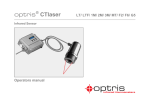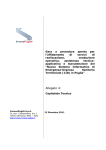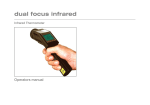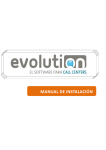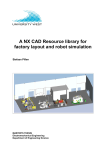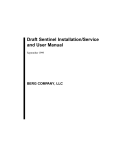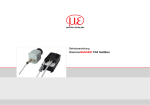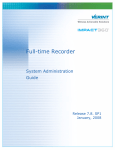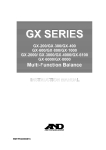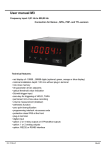Download Infrared Sensor with laser aiming Operators manual
Transcript
Infrared Sensor with laser aiming Operators manual thermoMETER CTL/CTLF/CTLG/CTLM-1/CTLM-2/CTLM-3 CE-Conformity The product complies with the following standards: EMC: Safety Regulations: EN 61326-1 EN 61010-1:1993/ A2:1995 The product accomplishes the requirements of the EMC Directive 89/336/EEC. Read the manual carefully before the initial start-up. The producer reserves the right to change the herein described specifications in case of technical advance of the product. Warranty All components of the device have been checked and tested for perfect function in the factory. In the unlikely event that errors should occur despite our thorough quality control, this should be reported immediately to MICRO-EPSILON. The warranty period lasts 12 months following the day of shipment. Defective parts, except wear parts, will be repaired or replaced free of charge within this period if you return the device free of cost to MICRO-EPSILON. This warranty does not apply to damage resulting from abuse of the equipment and devices, from forceful handling or installation of the devices or from repair or modifications performed by third parties. No other claims, except as warranted, are accepted. The terms of the purchasing contract apply in full. MICROEPSILON will specifically not be responsible for eventual consequential damages. MICRO-EPSILON always strives to supply the customers with the finest and most advanced equipment. Development and refinement is therefore performed continuously and the right to design changes without prior notice is accordingly reserved. For translations in other languages, the data and statements in the German language operation manual are to be taken as authoritative. Content 1 1.1 1.2 1.3 1.4 1.5 2 2.1 2.2 3 4 5 6 7 8 9 9.1 9.2 9.3 10 10.1 Description .......................................................................................................................... 7 Scope of Supply ................................................................................................................. 7 Maintenance........................................................................................................................ 8 Cautions .............................................................................................................................. 8 Model Overview .................................................................................................................. 9 Factory Default Settings.................................................................................................... 11 Technical Data .................................................................................................................. 12 General Specifications...................................................................................................... 12 Electrical Specifications.................................................................................................... 13 Measurement Specifications [CTL, CTL F] ...................................................................... 14 Measurement Specifications [M-1/ M-2 models] ............................................................. 15 Measurement Specifications [M-3 models] ..................................................................... 16 Measurement Specifications [G models]......................................................................... 17 Optical Charts ................................................................................................................... 18 Mechanical Installation ..................................................................................................... 32 Mounting Accessories ...................................................................................................... 34 Air Purge Collar................................................................................................................. 34 Mounting Bracket.............................................................................................................. 35 Water Cooled Housing ..................................................................................................... 36 Electrical Installation ......................................................................................................... 38 Cable Connections ........................................................................................................... 38 10.2 10.3 10.4 10.5 10.5.1 10.5.2 11 11.1 11.1.1 11.1.2 11.2 11.2.1 11.2.1.1 11.2.1.2 11.2.2 11.2.2.1 11.2.2.2 11.2.3 11.2.3.1 11.2.3.2 11.2.4 11.2.5 11.2.5.1 Power supply .................................................................................................................... 39 Cable Assembling............................................................................................................. 39 Ground Connection .......................................................................................................... 41 Exchange of the Sensing Head........................................................................................ 42 Entering of the Calibration Code ...................................................................................... 42 Exchange of the Head Cable............................................................................................ 44 Outputs and Inputs ........................................................................................................... 46 Analog Outputs ................................................................................................................. 46 Output channel 1 .............................................................................................................. 46 Output channel 2 [only for CTL, CTLF, G] ....................................................................... 47 Digital Interfaces ............................................................................................................... 47 USB Interface Kit............................................................................................................... 48 Scope of Supply ............................................................................................................... 48 Installation ......................................................................................................................... 49 RS232 Interface Kit ........................................................................................................... 50 Scope of Supply ............................................................................................................... 50 Installation ......................................................................................................................... 50 RS485 Interface Kit ........................................................................................................... 52 Scope of Supply ............................................................................................................... 52 Installation ......................................................................................................................... 52 CAN Bus Interface............................................................................................................. 55 Profibus-Accessory-Kit...................................................................................................... 57 Scope of supply ................................................................................................................ 57 11.2.5.2 11.2.5.3 11.2.6 11.2.6.1 11.2.6.2 11.2.6.3 11.2.6.4 11.3 11.4 11.5 11.5.6 11.5.7 12 12.1 12.2 12.3 12.4 12.5 12.6 13 13.1 13.2 13.3 Installation ......................................................................................................................... 57 Commissioning Profibus................................................................................................... 59 Ethernet-interface.............................................................................................................. 62 Scope of supply ................................................................................................................ 62 Installation ......................................................................................................................... 62 Installation of the CT Ethernet Adapter in a Network....................................................... 63 Uninstall the CT Ethernet Adapter in a Network .............................................................. 65 Relay Outputs ................................................................................................................... 66 Functional Inputs .............................................................................................................. 67 Alarms ............................................................................................................................... 68 Output channel 1 and 2 .................................................................................................... 68 Visual Alarms..................................................................................................................... 68 Operating .......................................................................................................................... 69 Sensor Setup .................................................................................................................... 69 Set factory defaults ........................................................................................................... 70 Emissivity, Statistic, Prescriptive limits ............................................................................. 73 Digital Command Set........................................................................................................ 79 Laser Sighting ................................................................................................................... 80 Error messages................................................................................................................. 80 Software ............................................................................................................................ 81 Installation ......................................................................................................................... 81 System Requirements....................................................................................................... 82 Features ............................................................................................................................ 82 14 Basics of Infrared Thermometry ....................................................................................... 83 15 Emissivity .......................................................................................................................... 84 15.1 Definition ........................................................................................................................... 84 15.2 Determination of unknown Emissivity .............................................................................. 85 15.3 Characteristic Emissivity ................................................................................................... 86 Appendix A – Emissivity Table Metals............................................................................................. 87 Appendix B – Emissivity Table Non Metals ..................................................................................... 89 Description 1 Description The sensors of the CTL series are noncontact infrared temperature sensors. They calculate the surface temperature based on the emitted infrared energy of objects [► Basics of Infrared Thermometry]. An integrated double laser aiming marks the real measurement spot location and spot size at any distance on the object surface. The sensor housing of the CTL head is made of stainless steel (IP65/ NEMA-4 rating) – the sensor electronics is placed in a separate box made of die casting zinc. The CTL sensing head is a sensitive optical system. Please use only the thread for mechanical installation. Avoid mechanical violence on the head – this may destroy the system (expiry of warranty). 1.1 • • • Scope of Supply CTL sensing head with connection cable and electronic box Mounting nut and mounting bracket (fixed) Operators manual thermoMETER CTL/CTLF/CTLG/CTLM-1/CTLM-2/CTLM-3 7 Description 1.2 Maintenance Lens cleaning: Blow off loose particles using clean compressed air. The lens surface can be cleaned with a soft, humid tissue moistened with water or a water based glass cleaner. PLEASE NOTE: Never use cleaning compounds which contain solvents (neither for the lens nor for the housing). 1.3 Cautions Avoid static electricity, arc welders, and induction heaters. Keep away from very strong EMF (electromagnetic fields). Avoid abrupt changes of the ambient temperature. In case of problems or questions which may arise when you use the CTL, please contact our service department. thermoMETER CTL/CTLF/CTLG/CTLM-1/CTLM-2/CTLM-3 8 Description 1.4 Model Overview The sensors of the CTL series are available in the following basic versions: Model CTL CTLF CTLM-1 CTLM-2 CTLM-3 CTLG Measurement range -40 to 975 °C -40 to 975 °C 485 to 1800 °C 250 to 1600 °C 50 to 600 °C 100 to 1650 °C spectral response 8-14 µm 8-14 µm 1 µm 1.6 µm 2.3 µm 5.2 µm typical applications non-metallic surfaces fast processes metals and ceramic surfaces metals and ceramic surfaces metals and composite materials measurement of glass On the CTLM-1, CTLM-2, CTLM-3 and CTLG models the whole measurement range is split into two sub ranges (L and H). thermoMETER CTL/CTLF/CTLG/CTLM-1/CTLM-2/CTLM-3 9 Description Lower limit temperature range [°C] Upper limit temperature range [°C] Lower alarm limit [°C] (normally closed) Upper alarm limit [°C] (normally open) Lower limit signal output Upper limit signal output Temperature unit Ambient temperature compensation Baud rate [kBaud] Laser CTL/CTLF 0 500 30 M-1L 485 1050 600 M-1H 650 1800 800 M-2L 250 800 350 M-2H 385 1600 500 M-3L 50 375 100 M-3H 100 600 200 GL 100 1200 200 GH 250 1650 3500 100 900 1400 600 1200 300 500 500 900 0V 5V °C head temperature probe (Output at OUT-AMB: 0-5 V ► -20–180 °C; not available on 1M and 2M models) CTL: 9.6 / M-xL, M-xH: 115 inactive thermoMETER CTL/CTLF/CTLG/CTLM-1/CTLM-2/CTLM-3 10 Description 1.5 Factory Default Settings The unit has the following presetting at time of delivery: Signal output object temperature Emissivity Transmissivity Average time (AVG) Smart Averaging Peak hold Valley hold 0–5V 0.970 (1.000 at CTLM) 1.000 0.2 s/ CTLF: 0.1 s/ M-1, M-2, M-3: inactive inactive (CTLF: active) Inactive inactive Smart Averaging means a dynamic average adaptation at high signal edges. [Activation via software only]. thermoMETER CTL/CTLF/CTLG/CTLM-1/CTLM-2/CTLM-3 11 Technical Data 2 2.1 Technical Data General Specifications Environmental rating Ambient temperature 1) Storage temperature Relative humidity Material Dimensions Weight Cable length Cable diameter Ambient temperature cable Vibration Shock EMI Sensing head Electronic box IP65 (NEMA-4) IP65 (NEMA-4 -20...85 °C 0...85 °C -40...85 °C -40...85 °C 10...95 %, non condensing 10...95 %, non condensing stainless steel die casting zinc 100 mm x 50 mm, M48x1,5 89 mm x 70 mm x 30 mm 600 g 420 g 3 m (Standard), 8 m, 15 m 5 mm 105 °C max. [High temperature cable (optional): 180 °C] IEC 68-2-6: 3G, 11 – 200Hz, any axis IEC 68-2-27: 50G, 11ms, any axis 89/336/EWG Tab. 2.1: General specifications 1) Laser will turn off automatically at ambient temperatures >50 °C. thermoMETER CTL/CTLF/CTLG/CTLM-1/CTLM-2/CTLM-3 12 Technical Data 2.2 Electrical Specifications Power Supply Current draw Aiming laser Outputs/ analog 8–36 VDC max. 160 mA 635 nm, 1 mW, On/ Off via programming keys or software Channel 1 Channel 2 (L/ LF/ G5) Alarm output Output impedances mA mV Thermocouple Digital interfaces Relay outputs Functional inputs selectable: 0/ 4–20 mA, 0–5/ 10 V, thermocouple (J or K) or alarm output (Signal source: object temperature) Head temperature [-20...180 °C] as 0–5 V or 0–10 V output or alarm output (Signal source switchable to object temperature or electronic box temperature if used as alarm output) Open collector output at Pin AL2 [24 V/ 50 mA] max. loop resistance 500 Ω (at 8-36 VDC), min. 100 KΩ load impedance 20 Ω USB, RS232, RS485, CAN, Profibus DP, Ethernet (optional plug-in modules) 2 x 60 VDC/ 42 VACRMS, 0,4 A; optically isolated (optional plug-in module) F1-F3; software programmable for the following functions: • external emissivity adjustment, • ambient temperature compensation, • trigger (reset of hold functions) Tab. 2.2: Electrical specifications thermoMETER CTL/CTLF/CTLG/CTLM-1/CTLM-2/CTLM-3 13 Measurement Specifications [CTL, CTL F] 3 Measurement Specifications [CTL, CTL F] Temperature range (scalable) Spectral range Optical resolution System accuracy 1) 2) Repeatability 1) 2) Temperature resolution (NETD) Response time (90% signal) Warm-up time Emissivity/ Gain Transmissivity Signal processing Software CTL CTLF -40...975 °C -40...975 °C 8...14 µm 8...14 µm 75:1 50:1 ±1 °C or ±1 % 3) ±1.5 °C or ±1.5 % 4) ±0,5 °C or ±0,5 % 3) ±1 °C or ±1 % 4) 0.1 °C 3) 0.5 °C 4) 120 ms 9 ms 10 min 10 min 0.100…1.100 (adjustable via programming keys or software) 0.100…1.000 (adjustable via programming keys or software) Average, peak hold, valley hold (adjustable via programming keys or software) optional Tab. 3.1: Measurement specifications [CTL, CTL F] 1) at ambient temperature 23±5 °C; whichever is greater Accuracy for thermocouple output: ±2.5 °C or ±1 % 3) at object temperatures >0 °C 4) at object temperatures ≥20 °C 2) thermoMETER CTL/CTLF/CTLG/CTLM-1/CTLM-2/CTLM-3 14 Measurement Specifications [M-1/ M-2 models] 4 Measurement Specifications [M-1/ M-2 models] Temperature range (scalable) Spectral range Optical resolution System accuracy 1) 2) Repeatability 1) Temperature resolution 3) Exposure time (90% signal) Emissivity/ Gain Transmissivity Signal processing Software M-1L 485...1050 °C 1 µm 150:1 M-1H M-2L M-2H 650...1800 °C 250...800 °C 385...1600 °C 1 µm 1.6 µm 1.6 µm 300:1 150:1 300:1 ±(0.3 % of reading +2 °C) 3) ±(0.1 % of reading +1 °C) 3) M-xL: 0.1 °C / M-xH: 0.2 °C 1 ms 4) 0.100…1.100 (adjustable via programming keys or software) 0.100…1.000 (adjustable via programming keys or software) Average, peak hold, valley hold (adjustable via programming keys or software optional Tab. 4.1: Measurement specifications [M-1/ M-2 models] 1) at ambient temperature 23±5 °C; whichever is greater Accuracy for thermocouple output: ±2.5 °C or ±1 % 3) ε = 1/ Response time 1 s 4) with dynamic adaptation at low signal levels 2) thermoMETER CTL/CTLF/CTLG/CTLM-1/CTLM-2/CTLM-3 15 Measurement Specifications [M-3 models] 5 Measurement Specifications [M-3 models] Temperature range (scalable) Spectral range Optical resolution System accuracy 1) 2) Repeatability 1) Temperature resolution 3) Exposure time (90% signal) Emissivity/ Gain Transmissivity Signal processing Software M-3L 50...375 °C 2.3 µm 60:1 M-31H 100...600 °C 2.3 µm 100:1 ±(0.3 % of reading +2 °C) 3) ±(0.1 % of reading +1 °C) 3) 0,1 °C 3) 1 ms 4) 0.100…1.100 (adjustable via programming keys or software) 0.100…1.000 (adjustable via programming keys or software) Average, peak hold, valley hold (adjustable via programming keys or software optional Tab. 5.1: Measurement specifications [M-3 models] 1) at ambient temperature 23±5 °C; whichever is greater Accuracy for thermocouple output: ±2.5 °C or ±1 % 3) ε = 1/ Response time 1 s 4) with dynamic adaptation at low signal levels 2) thermoMETER CTL/CTLF/CTLG/CTLM-1/CTLM-2/CTLM-3 16 Measurement Specifications [G models] 6 Measurement Specifications [G models] Temperature range (scalable) Spectral range Optical resolution Accuracy 1) 2) Repeatability 1) 2) Temperature resolution (NETD) Response time (90% signal) Warm-up time Emissivity/ Gain Transmissivity Signal processing Software GL 100...1200 °C 5.2 µm 45:1 ±1 °C or ±1 % ±0.5 °C or ±0.5 % 0.1 °C 120 ms GH 250...1650 °C 5.2 µm 70:1 ±1 °C or ±1 % ±0.5 °C or ±0.5 % 0.2 °C 80 ms 10 min 0.100…1.100 (adjustable via programming keys or software) 0.100…1.000 (adjustable via programming keys or software) Average, peak hold, valley hold (adjustable via programming keys or software) optional Tab. 6.1: Measurement specifications [G models] 1) 2) at ambient temperature 23±5 °C; whichever is greater Accuracy for thermocouple output: ±2.5 °C or ±1 % thermoMETER CTL/CTLF/CTLG/CTLM-1/CTLM-2/CTLM-3 17 Optical Charts 7 Optical Charts The following optical charts show the diameter of the measuring spot in dependence on the distance between measuring object and sensing head. The spot size refers to 90 % of the radiation energy. The distance is always measured from the front edge of the sensing head. The size of the measuring object and the optical resolution of the infrared thermometer determine the maximum distance between sensing head and measuring object. In order to prevent measuring errors the object should fill out the field of view of the optics completely. Consequently, the spot should at all times have at least the same size like the object or should be smaller than that. D = Distance from front of the sensing head to the object S = Spot size thermoMETER CTL/CTLF/CTLG/CTLM-1/CTLM-2/CTLM-3 18 Optical Charts CTL Optik: SF D:S (Focus distance) = 75:1 16 mm @ 1200 mm D:S (Far field) = 34:1 CTL Optik: CF1 D:S (Focus distance) = 75:1 0.9 mm @ 70 mm D:S (Far field) = 3,5:1 thermoMETER CTL/CTLF/CTLG/CTLM-1/CTLM-2/CTLM-3 19 Optical Charts CTL Optik: CF2 D:S (Focus distance) = 75:1 1.9 mm @ 150 mm D:S (Far field) = 7:1 CTL Optik: CF3 D:S (Focus distance) = 75:1 2.75 mm @ 200 mm D:S (Far field) = 9:1 thermoMETER CTL/CTLF/CTLG/CTLM-1/CTLM-2/CTLM-3 20 Optical Charts CTL Optik: CF4 D:S (Focus distance) = 75:1 5.9 mm @ 450 mm D:S (Far field) = 18:1 CTLF Optik: SF D:S (Focus distance) = 50:1 24 mm @ 1200 mm D:S (Far field) = 20:1 thermoMETER CTL/CTLF/CTLG/CTLM-1/CTLM-2/CTLM-3 21 Optical Charts CTLF Optik: CF1 D:S (Focus distance) = 50:1 1.4 mm @ 70 mm D:S (Far field) = 1,5:1 CTLF Optik: CF2 D:S (Focus distance) = 50:1 3 mm @ 150 mm D:S (Far field) = 6:1 thermoMETER CTL/CTLF/CTLG/CTLM-1/CTLM-2/CTLM-3 22 Optical Charts CTLF Optik: CF3 D:S (Focus distance) = 50:1 4 mm @ 200 mm D:S (Far field) = 8:1 CTLF Optik: CF4 D:S (Focus distance) = 50:1 9 mm @ 450 mm D:S (Far field) = 16:1 thermoMETER CTL/CTLF/CTLG/CTLM-1/CTLM-2/CTLM-3 23 Optical Charts M-1H/ M-2H Optik: FF D:S (Focus distance) = 300:1 12 mm @ 3600 mm D:S (Far field) = 115:1 M-1L/ M-2L Optik: FF D:S (Focus distance) = 150:1 24 mm @ 3600 mm D:S (Far field) = 84:1 M-1H/ M-2H Optik: SF D:S (Focus distance) = 300:1 3.7 mm @1100 mm D:S (Far field) = 48:1 M-1L/ M-2L Optik: SF D:S (Focus distance) = 150:1 7.3 mm @ 1100 mm D:S (Far field) = 42:1 thermoMETER CTL/CTLF/CTLG/CTLM-1/CTLM-2/CTLM-3 24 Optical Charts M-1H/ M-2H Optik: CF2 D:S (Focus distance) = 300:1 0.5 mm @ 150 mm D:S (Far field) = 7,5:1 M-1L/ M-2L Optik: CF2 D:S (Focus distance) = 150:1 1 mm @ 150 mm D:S (Far field) = 7:1 M-1H/ M-2H Optik: CF3 D:S (Focus distance) = 300:1 0.7 mm @ 200 mm D:S (Far field) = 10:1 M-1L/ M-2L Optik: CF3 D:S (Focus distance) = 150:1 1.3 mm @ 200 mm D:S (Far field) = 10:1 thermoMETER CTL/CTLF/CTLG/CTLM-1/CTLM-2/CTLM-3 25 Optical Charts M-1H/ M-2H Optik: CF4 D:S (Focus distance) = 300:1 1.5 mm @ 450 mm D:S (Far field) = 22:1 M-1L/ M-2L Optik: CF4 D:S (Focus distance) = 150:1 3 mm @ 450 mm D:S (Far field) = 20:1 thermoMETER CTL/CTLF/CTLG/CTLM-1/CTLM-2/CTLM-3 26 Optical Charts M-3H Optik: CF1 D:S (Focus distance) = 100:1 0.7 mm @ 70 mm D:S (Far field) = 3:1 M-3L Optik: CF1 D:S (Focus distance) = 60:1 1.2 mm @ 70 mm D:S (Far field) = 3:1 M-3H Optik: CF2 D:S (Focus distance) = 100:1 1.5 mm @ 150 mm D:S (Far field) = 7:1 M-3L Optik CF2 D:S (Focus distance) = 60:1 2.5 mm @ 150 mm D:S (Far field) = 6:1 thermoMETER CTL/CTLF/CTLG/CTLM-1/CTLM-2/CTLM-3 27 Optical Charts M-3H Optik: CF3 D:S (Focus distance) = 100:1 2 mm @ 200 mm D:S (Far field) = 9:1 M-3L Optik: CF3 D:S (Focus distance) = 60:1 3.4 mm @ 200mm D:S (Far field) = 8:1 M-3H Optik: CF4 D:S (Focus distance) = 100:1 4.5 mm @ 450 mm D:S (Far field) = 19:1 M-3L Optik: CF4 D:S (Focus distance) = 60:1 7.5 mm @ 450 mm D:S (Far field) = 17:1 thermoMETER CTL/CTLF/CTLG/CTLM-1/CTLM-2/CTLM-3 28 Optical Charts M-3H Optik: SF D:S (Focus distance) = 100:1 11 mm @ 1100 mm D:S (Far field) = 38:1 M-3L Optik: SF D:S (Focus distance) = 60:1 8.3 mm @ 1100 mm D:S (Far field) = 30:1 GL Optik: SF D:S (Focus distance) = 45:1 27 mm @ 1200 mm D:S (Far field) = 25:1 GH Optik: SF D:S (Focus distance) = 70:1 17 mm @ 1200 mm D:S (Far field) = 33:1 thermoMETER CTL/CTLF/CTLG/CTLM-1/CTLM-2/CTLM-3 29 Optical Charts GL Optik: CF1 D:S (Focus distance) = 45:1 1.6 mm @ 70 mm D:S (Far field) = 3:1 GH Optik: CF1 D:S (Focus distance) = 70:1 1 mm @ 70 mm D:S (Far field) = 3.4:1 GL Optik: CF2 D:S (Focus distance) = 45:1 3.4 mm @ 150 mm D:S (Far field) = 6:1 GH Optik: CF2 D:S (Focus distance) = 70:1 2.2 mm @ 150 mm D:S (Far field) = 6.8:1 thermoMETER CTL/CTLF/CTLG/CTLM-1/CTLM-2/CTLM-3 30 Optical Charts GL Optik: CF3 D:S (Focus distance) = 45:1 4.5 mm @ 200 mm D:S (Far field) = 8:1 GH Optik: CF3 D:S (Focus distance) = 70:1 2.9 mm @ 200 mm D:S (Far field) = 9.2:1 GL Optik: CF4 D:S (Focus distance) = 45:1 10 mm @ 450 mm D:S (Far field) = 15:1 GH Optik: CF4 D:S (Focus distance) = 70:1 6.5 mm @ 450 mm D:S (Far field) = 17.7:1 thermoMETER CTL/CTLF/CTLG/CTLM-1/CTLM-2/CTLM-3 31 Mechanical Installation 8 Mechanical Installation The CTL is equipped with a metric M48x1.5 thread and can be installed either directly via the sensor thread or with help of the supplied mounting nut (standard) and fixed mounting bracket (standard) to a mounting device available. Fig. 8.1: CTL sensing head Make sure to keep the optical path clear of any objects. thermoMETER CTL/CTLF/CTLG/CTLM-1/CTLM-2/CTLM-3 32 Mechanical Installation Fig. 8.2: Electronic Box For an exact alignment of the head to the object please activate the integrated double laser. [► Operating/ Laser sighting] thermoMETER CTL/CTLF/CTLG/CTLM-1/CTLM-2/CTLM-3 33 Mechanical Installation Fig. 8.3: Mounting bracket, fixed – standard scope of supply thermoMETER CTL/CTLF/CTLG/CTLM-1/CTLM-2/CTLM-3 34 Mounting Accessories 9 9.1 Mounting Accessories Air Purge Collar The lens must be kept clean at all times from dust, smoke, fumes and other contaminants in order to avoid reading errors. These effects can be reduced by using an air purge collar. Make sure to use oil-free, technically clean air, only. Fig. 9.1: Air purge collar [TM-AP-CTL] The needed amount of air (approx. 2...10 l/ min.) depends on the application and the installation conditions on-site. thermoMETER CTL/CTLF/CTLG/CTLM-1/CTLM-2/CTLM-3 35 Mounting Accessories 9.2 Mounting Bracket Fig. 9.2: Mounting bracket, adjustable [TM-AB-CTL] The adjustable mounting bracket allows an adjustment of the sensor in two axis. thermoMETER CTL/CTLF/CTLG/CTLM-1/CTLM-2/CTLM-3 36 Mounting Accessories 9.3 Water Cooled Housing Fig. 9.3: Water cooled housing [TM-W-CTL] To avoid condensation on the optics an air purge collar is recommended. The sensing head can be used at ambient temperatures up to 85 °C without cooling. For applications, where the ambient temperature can reach higher values, the usage of the optional water cooled housing is recommended (operating temperature up to 175 °C). The sensor should be equipped with the optional high temperature cable (operating temperature up to 180 °C). ► All accessories can be ordered using the according part numbers in brackets [ ]. thermoMETER CTL/CTLF/CTLG/CTLM-1/CTLM-2/CTLM-3 37 Electrical Installation 10 Electrical Installation 10.1 Cable Connections For the electrical installation of the CTL please open at first the cover of the electronic box (4 screws). Below the display are the screw terminals for the cable connection. Designation [models CTL/ CTLF/ G] +8..36VDC GND GND OUT-AMB OUT-TC OUT-mV/mA F1-F3 AL2 3V SW GND BROWN WHITE GREEN YELLOW Power supply Ground (0V) of power supply Ground (0V) of internal in- and outputs Analog output head temperature (mV) Analog output thermocouple (J or K) Analog output object temperature (mV or mA) Functional inputs Alarm 2 (Open collector output) PINK/ Power supply Laser (+) GREY/ Ground Laser (–) Temperature probe head Temperature probe head Detector signal (–) Detector signal (+) Designation [models M] +8..36VDC GND GND AL2 OUT-TC OUT-mV/mA F1-F3 GND LASER GND PWR GND NTC VV thermoMETER CTL/CTLF/CTLG/CTLM-1/CTLM-2/CTLM-3 Power supply Ground (0V) of power supply Ground (0V) of internal in- and outputs Alarm 2 (Open collector output) Analog output thermocouple (J or K) Analog output object temperature (mV or mA) Functional inputs Ground (0V) PINK/ Power supply Laser (+) GREY/ Ground Laser (–) GREEN/ Head power WHITE/ Head ground BROWN/ Temperature probe head (NTC) YELLOW/ Detector signal 38 Electrical Installation Fig. 10.1: Opened electronic box with terminal connections 10.2 Power supply Please use a power supply unit with an output voltage of 8–36 VDC which can supply 160 mA. CAUTION: Please do never connect a supply voltage to the analog outputs as this will destroy the output! The CTL is not a 2-wire sensor! thermoMETER CTL/CTLF/CTLG/CTLM-1/CTLM-2/CTLM-3 39 Electrical Installation 10.3 Cable Assembling The cable gland M12x1.5 allows the use of cables with a diameter of 3 to 5 mm. Remove the isolation from the cable (40 mm power supply, 50 mm signal outputs, 60 mm functional inputs). Cut the shield down to approximately 5 mm and spread the strands out. Extract about 4 mm of the wire isolation and tin the wire ends. Place the pressing screw, the rubber washer and the metal washers of the cable gland one after the other onto the prepared cable end. Spread the strands and fix the shield between two of the metal washers. Insert the cable into the cable gland until the limit stop. Screw the cap tight. Every single wire may be connected to the according screw clamps according to their colors. Fig. 10.2: Cable Assembling Use shielded cables only. The sensor shield has to be grounded. thermoMETER CTL/CTLF/CTLG/CTLM-1/CTLM-2/CTLM-3 40 Electrical Installation 10.4 Ground Connection At the bottom side of the main board PCB you will find a connector (jumper) which has been placed from factory side as shown in the picture [left and middle pin connected]. In this position the ground connections (GND power supply/ outputs) are connected with the ground of the electronics housing. To avoid ground loops and related signal interferences in industrial environments it might be necessary to interrupt this connection. To do this please put the jumper in the other position [middle and right pin connected]. If the thermocouple output is used the connection GND – housing should be interrupted generally. Fig. 10.3: Connector (Jumper) thermoMETER CTL/CTLF/CTLG/CTLM-1/CTLM-2/CTLM-3 41 Electrical Installation 10.5 Exchange of the Sensing Head From factory side the sensing head has already been connected to the electronics. Inside the model group CTL and inside the model group G an exchange of sensing heads and electronics is possible. The sensing heads and electronics of the models CTLF, M-1L, M-1H, M-2L, M-2H, M-3L, and M-3 H cannot be exchanged. After exchanging a head the calibration code of the new head must be entered into the electronics. 10.5.1 Entering of the Calibration Code Every head has a specific calibration code, which is printed on the head. For a correct temperature measurement and functionality of the sensor this calibration code must be stored into the electronic box. The calibration code consists of five blocks with 4 characters each. Example: EKJ0 – 0OUD – 0A1B – A17U – 93OZ block1 block2 block3 block4 block5 For entering the code please press the Up and Down key (keep pressed) and then the Mode key. The display shows HCODE and then the 4 signs of the first block. With Up and Down each sign can be changed, Mode switches to the next sign or next block. thermoMETER CTL/CTLF/CTLG/CTLM-1/CTLM-2/CTLM-3 42 Electrical Installation Fig. 10.4: Calibration Code You will find the calibration code on a label fixed on the head. Please do not remove this label or make sure the code is noted anywhere. The code is needed if the head has to be exchanged. 10.5.2 Exchange of the Head Cable The sensing head cable can also be exchanged if necessary. For a dismantling on the head side please open at first the cover plate on the back side of the head. Then please remove the terminal block and loose the connections. After the new cable has been installed please do the same steps in reverse order. Please take care the cable shield is properly connected to the head housing. As exchange cable a cable type with same wire profiles and specification should be used to avoid influences on the accuracy. thermoMETER CTL/CTLF/CTLG/CTLM-1/CTLM-2/CTLM-3 43 Electrical Installation Fig. 10.5: View on terminal block with sensor cables thermoMETER CTL/CTLF/CTLG/CTLM-1/CTLM-2/CTLM-3 44 Outputs and Inputs 11 Outputs and Inputs 11.1 Analog Outputs The CTL has two analog output channels. 11.1.1 Output channel 1 This output is used for the object temperature. The selection of the output signal can be done via the programming keys [► Operating]. The software allows the programming of output channel 1 as an alarm output. Output signal Voltage Voltage Current Current Thermocouple Thermocouple Range 0 ... 5 V 0 ... 10 V 0 ... 20 mA 4 ... 20 mA TC J TC K Connection pin on CTL board OUT-mV/mA OUT-mV/mA OUT-mV/mA OUT-mV/mA OUT-TC OUT-TC According to the chosen output signal there are different connection pins on the main board (OUT-mV/mA or OUT-TC). thermoMETER CTL/CTLF/CTLG/CTLM-1/CTLM-2/CTLM-3 45 Outputs and Inputs 11.1.2 Output channel 2 [only for CTL, CTLF, G] The connection pin OUT AMB is used for output of the head temperature [-20–180 °C as 0–5 V or 0–10 V signal]. The software allows the programming of output channel 2 as an alarm output. Instead of the head temperature THead also the object temperature TObj or electronic box temperature TBox can be selected as alarm source. 11.2 Digital Interfaces The controller can be optionally equipped with an USB-, RS232-, RS485-, CAN Bus-, Profibus DP- or Ethernet-interface. If you want to install an interface, plug the interface board into the place provided, which is located beside the display. In the correct position the holes of the interface match with the thread holes of the electronic box. Now press the board down to connect it and use both M3x5 screws for fixing it. Plug the preassembled interface cable with the terminal block into the male connector of the interface board. The Ethernet interface requires at minimum 12 V supply voltage. Please pay attention to the notes on the according interface manuals. thermoMETER CTL/CTLF/CTLG/CTLM-1/CTLM-2/CTLM-3 46 Outputs and Inputs Fig. 11.1: CTL controller with Interface board 11.2.1 11.2.1.1 USB Interface Kit Scope of Supply USB interface board Software CD USB adapter cable Terminal block Cable gland Mounting screws and cable tie thermoMETER CTL/CTLF/CTLG/CTLM-1/CTLM-2/CTLM-3 47 Outputs and Inputs 11.2.1.2 Installation Please plug the USB interface into the place provided, which is located beside the display. In the correct position the holes of the USB interface match with the thread holes of the controller. Now press the PCB downwards and fix it using both M3x5 screws. Exchange the blind screw on the controller by the cable gland and install the USB adapter cable. Make sure the wiring is correct according to the wire colours printed on the interface board. NOTE: For industrial installations it is recommended to connect the shield of the USB adapter cable with the electronics housing (inside the cable gland). The CTL needs no external power supply for operation – it will be powered by the USB interface. If an external power supply has already been installed, this will have no effect on the functionality of the CTL. Fig. 11.2: CTL controller with USB Interface thermoMETER CTL/CTLF/CTLG/CTLM-1/CTLM-2/CTLM-3 48 Outputs and Inputs 11.2.2 11.2.2.1 1 pcs. 1 pcs. 1 pcs. 1 pcs. 11.2.2.2 • • • RS232 Interface Kit Scope of Supply Package Quick reference Software CD RS232-interface cable preassembled 1 pcs. 1 pcs. 2 pcs. 1 pcs. Cable gland M12x1.5 RS232-Interface Screw M3x5 Cable tie Installation Please take the RS232-interface out from the packaging and plug it into the place provided, which is located beside the display. In the correct position the holes of the RS232 interface match with the thread holes of the controller. Now press the RS232 interface down to connect it with the CTL. Use both M3x5 screws for fixing the interface. Plug the preassembled RS232-interface cable with the terminal block into the male connector of the RS232-interface. In case you want to use the delivered cable gland M12x1.5 for the RS232 cable, the terminal block has to be disassembled/ assembled. Make sure the wiring is correct. thermoMETER CTL/CTLF/CTLG/CTLM-1/CTLM-2/CTLM-3 49 Outputs and Inputs The CTL always needs an external power supply for operation. Please install the software CTL connect as described in the operators manual. After you have connected the RS232-cable to your PC and started the software the communication will be established. The setting for baud rate in the software must be the same as on the CTL unit (factory default: 9.6 kBaud). Fig. 11.3: Correct wiring 11.2.3 11.2.3.1 1 pcs. 1 pcs. 1 pcs. 1 pcs. 1 pcs. RS485 Interface Kit Scope of Supply Packaging Quick reference Software CD (CTconnect, CTmulti) USB cable RS485-interface 1 pcs. 1 pcs. 2 pcs. 1 pcs. 3 pcs. thermoMETER CTL/CTLF/CTLG/CTLM-1/CTLM-2/CTLM-3 RS485-USB-Adapter Cable gland M12x1.5 Screw M3x5 Cable tie Terminal block on the board 50 Outputs and Inputs 11.2.3.2 • • • • • • Installation Please connect the RS485-USB-adapter via the supplied USB cable with your computer. After it has been connected the computer will recognize a new USB-device and (if connected the first time) will ask for installation of the according driver software. Please select Search and install the RS485 Adapter USB Driver from the software CD. Please take the RS485-interface out from the packaging and plug it into the place provided, which is located beside the display. In the correct position the holes of the RS485 interface match with the thread holes of the controller. Now press the RS485-interface down to connect it with the CTL. Use both M3x5 screws for fixing the board. The RS485-USB-adapter is providing a 2-wire half-duplex mode. Please connect terminal A of the adapter with terminal A of the RS485-interface of the first CTL and from there to terminal A of the next CTL and so on (Fig. 2). With the B terminals proceed as well. Make sure, that you always connect A to A and B to B, not reverse. You may run up to 32 CTL units on one RS485-USB-adapter. The 120R-switch is to be turned to ON at one of the connected CTL units, only. Each CTL unit connected to the RS485 needs a different multidrop address (1...32). Please adjust the address by pressing the mode button until M xx appears in the display. Using the Up- and Down-keys you can change the shown address (xx). The address can also be changed with the CTL connect software. The setting for baud rate in the software must be the same as on the CTL unit (factory default: 9.6 kBaud). thermoMETER CTL/CTLF/CTLG/CTLM-1/CTLM-2/CTLM-3 51 Outputs and Inputs OFF 120R ON A B A B RS485 Interface OFF 120R ON A B A B RS485 Interface OFF 120R ON A B A B USB cable ; Kabel RS485 Interface RS485 to USB adaptor RS485 zu USB Adapter A B PC 120R switch OFF 120R Schalter OFF Multidrop Adress 1 120R switch OFF 120R Schalter OFF Multidrop Adress n 120R switch ON 120R Schalter ON Multidrop Adress 32 Fig. 11.4: Correct wiring thermoMETER CTL/CTLF/CTLG/CTLM-1/CTLM-2/CTLM-3 52 Outputs and Inputs 11.2.4 CAN Bus Interface CAN Protocol CAN open (see documentation on CD) Wiring CAN Bus: CAN_H on terminal „H“ CAN_L on terminal „L“ Analog signal: Black cord on terminal „GND“ Black cord on terminal „OUT-mV“ The controller contains additional terminals to connect other devices (power supply, CAN bus, terminating resistor). CAN module settings Module address: 20 (14H) Baud rate: 250 kBaud Analog input: 0 … 10 V Temperature range: 0 … 60 °C (2 decimal places) Emission ratio: 0.970 Note: The settings for “Analog output 0 … 10 V“ and "Temperature range 0 … 60 °C" must be identical with the CAN bus module values. thermoMETER CTL/CTLF/CTLG/CTLM-1/CTLM-2/CTLM-3 53 Outputs and Inputs Settings Address and Baud rate CAN open-Service "LSS / Layer Setting Services" Index Temperature value: The temperature information is located in the object register 7130h (Sub01): e.g. B4: LB B5: HB B4: DA B5: 07 T = 20.10 °C Diagnosis If the power supply is on, the LED displays one of the following conditions: State Meaning Flashes quickly Device is in preoperational mode Off Power supply is not correct / faulty hardware Illuminates Device is in operational mode Sparkles Device is stopped thermoMETER CTL/CTLF/CTLG/CTLM-1/CTLM-2/CTLM-3 54 Outputs and Inputs 11.2.5 11.2.5.1 1 pcs. 1 pcs. 1 pcs. 1 pcs. 11.2.5.2 • • • Profibus-Accessory-Kit Scope of supply Packaging Quick reference Software CD Profibus-interface cable preassembled 1 pcs. 1 pcs. 2 pcs. Cable gland M12x1.5 Profibus-DPv1-interface Screws M3x5 Installation Please take the Profibus-DPv1-interface out from the packaging and plug it into the place provided, which is located beside the display. In the correct position the holes of the Profibus-DPv1-interface match with the thread holes of the CT box. Now press the Profibus DPv1-interface down to connect it with the CT. Use both M3x5 screws for fixing the interface. Plug the preassembled Profibus-DPv1 interface cable with the terminal block into the male connector of the Profibus-DPv1-interface. In case you want to use the delivered cable gland M12x1.5 for the Profibus cable, the terminal block has to be disassembled/ assembled. Make sure the wiring is correct (Fig. 2). NOTE: For industrial installations it is recommended to connect the shield of the Profibus-cable with the electronics housing (inside the cable gland). thermoMETER CTL/CTLF/CTLG/CTLM-1/CTLM-2/CTLM-3 55 Outputs and Inputs The CT always needs an external power supply for operation. Fig. 11.5: Correct wiring thermoMETER CTL/CTLF/CTLG/CTLM-1/CTLM-2/CTLM-3 56 Outputs and Inputs 11.2.5.3 Commissioning Profibus 1. Read in the „IT010A90.gsd“ GSD file into the PLC configuration tool and configure the controller. At least one module must be selected. You will find more information about the Profibus interface on the enclosed CD-ROM. 2. Open the controller and connect the power supply, see figure below. Profibus cable Power supply Sensor cable GND +8 up to +36 VDC thermoMETER CTL/CTLF/CTLG/CTLM-1/CTLM-2/CTLM-3 57 Outputs and Inputs 3. Switch on the power supply. 4. Press the Mode button 18 times until the item „SL001“ appears. Set the slave address with the „UP“ and „DOWN“ buttons. Valid slave addresses start with 001 up to 125. Use the same address as in the PLC configuration tool, see page 4 in the manual. 5. Switch off the controller for at least 3 seconds. 6. Connect the SUB-D connector of the Profibus cable with a Profibus port. Take care on the terminating resistor of the Profibus. 7. The controller with Profibus-DPv1 is now ready for data exchange with the Profibus master; see the manual on page 7. 8. The measurements are displayed in hex format and must be converted into decimals; see the manual on page 7. 9. The settings of the Profibus-DPv1 interface and the communication with the Profibus master are described in the manual on page 8 up to 31. thermoMETER CTL/CTLF/CTLG/CTLM-1/CTLM-2/CTLM-3 58 Outputs and Inputs 11.2.6 11.2.6.1 1 pcs. 1 pcs. 1 pcs. 1 pcs. 11.2.6.2 Ethernet-interface Scope of supply Packaging Quick reference Software CD Ethernet-interface preassembled 1 pcs. 1 pcs. 2 pcs. 1 pcs. Cable gland M12x1.5 Ethernet-interface Screw M3x5 Cable tie Installation • Please take the Ethernet interface out from the packaging and plug it into the place provided, which is located beside the display. In the correct position the holes of the interface match with the thread holes of the CT box. Now press the interface down to connect it with the CT. • Use both M3x5 screws for fixing the interface. Plug the interface box with the preassembled terminal block into the male connector of the Ethernet interface. In case you want to use the delivered cable gland M12x1.5 for the Ethernet box, the terminal block has to be disassembled/ assembled. The CT requires an external power supply in each case. 11.2.6.3 Installation of the CT Ethernet Adapter in a Network First install the driver software of the Ethernet adapter on the supplied CD (Compact Connect CD). To start the installation, start the file SETUP.EXE in the path: Driver/Ethernet_Adapter. The following dialog appears: thermoMETER CTL/CTLF/CTLG/CTLM-1/CTLM-2/CTLM-3 59 Outputs and Inputs Fig. 11.6: CT Ethernet Com Port Installation Enter the MAC address of the adapter in the field MAC Address. You will find the address on the housing. Select in the pull-down menu COM PORT the desired COM port or FIRST POSSIBLE for the first available COM port. Now click on the button INSTALL COM PORT. Installation is completed, if the letters in the button are black again. The COM port is now set in the Device Manager and can be used from the software Compact Connect. You will find a manual for Installation and operation of the Compact Connect software on the CD. thermoMETER CTL/CTLF/CTLG/CTLM-1/CTLM-2/CTLM-3 60 Outputs and Inputs 11.2.6.4 Uninstall the CT Ethernet Adapter in a Network To uninstall the driver software, start the file REMOVE.EXE on the supplied CD. The file is located in the path: Driver/Ethernet_Adapter. The following dialog appears: The dialog allows you to permanently remove a single module or all modules from the system. To install the CT Ethernet adapter in a direct connection to a PC you will find more information in the path: Manuals\Interfaces on the Compact Connect CD. thermoMETER CTL/CTLF/CTLG/CTLM-1/CTLM-2/CTLM-3 61 Outputs and Inputs 11.3 Relay Outputs The CTL can be optionally equipped with a relay output. The relay board will be installed the same way as the digital interfaces. A simultaneous installation of a digital interface and the relay outputs is not possible. The relay board provides two fully isolated switches, which have the capability to switch max. 60 VDC/ 42 VACRMS, 0.4 A DC/AC. A red LED shows the closed switch. The switching thresholds are in accordance with the values for alarm 1 and 2 [► Alarms/ Visual Alarms]. The alarm values are set according to the ► Factory Default Settings. To make advanced settings (change of low- and high alarm) a digital interface (USB, RS232) and the software is needed. Fig. 11.7: Relais Interface with correct wiring thermoMETER CTL/CTLF/CTLG/CTLM-1/CTLM-2/CTLM-3 62 Outputs and Inputs 11.4 Functional Inputs The three functional inputs F1 – F3 can be programmed with the software, only. F1 (digital): F2 (analog): F3 (analog): trigger (a 0 V level on F1 resets the hold functions) external emissivity adjustment [0–10 V: 0 V ► ε=0,1; 9 V ► ε=1; 10 V ► ε=1,1] external compensation of ambient temperature/ the range is scalable via software [0–10 V ► -40–900 °C / preset range: -20–200 °C] F1-F3 (digital): emissivity (digital choice via table, non-connected input represents high-level) High-level: ≥ +3 V…+36 V Low-level: ≤ +0.4 V…–36 V 11.5 Alarms The CTL has the following Alarm features: All alarms (alarm 1, alarm 2, output channel 1 and 2 if used as alarm output) have a fixed hysterese of 2 K. 11.5.6 Output channel 1 and 2 To activate the according output channel has to be switched into digital mode. For this purpose the software is required. thermoMETER CTL/CTLF/CTLG/CTLM-1/CTLM-2/CTLM-3 63 Outputs and Inputs 11.5.7 Visual Alarms These alarms will cause a change of the colour of the LCD display and will also change the status of the optional relays interface. In addition the Alarm 2 can be used as open collector output at pin AL2 on the main board [24V/ 50mA]. From factory side the alarms are defined as follows: Alarm 1 Alarm 2 Norm. closed/ Low-Alarm Norm. open/ High-Alarm Both of these alarms will have effect on the LCD colour: BLUE: Alarm 1 active RED: Alarm 2 active GREEN: No alarm active For extended setup like definition as low or high alarm [via change of normally open/ closed], selection of the signal source [TObj, THead, TBox] a digital interface (e.g. USB, RS232) including the software is needed. thermoMETER CTL/CTLF/CTLG/CTLM-1/CTLM-2/CTLM-3 64 Operating 12 Operating After power up the unit the sensor starts an initializing routine for some seconds. During this time the display will show INIT. After this procedure the object temperature is shown in the display. The display backlight colour changes according to the alarm settings [► Alarms/ Visual Alarms]. 12.1 Sensor Setup The programming keys Mode, Up and Down enable the user to set the sensor on-site. The current measuring value or the chosen feature is displayed. With Mode the operator obtains the chosen feature, with Up and Down the functional parameters can be selected – a change of parameters will have immediate effect. If no key is pressed for more than 10 seconds the display automatically shows the calculated object temperature (according to the signal processing). thermoMETER CTL/CTLF/CTLG/CTLM-1/CTLM-2/CTLM-3 65 Operating Fig. 12.1: Display and programming keys Pressing the Mode button again recalls the last called function on the display. The signal processing features Peak hold and Valley hold cannot be selected simultaneously. 12.2 Set factory defaults Factory Default Setting: To set the CTL back to the factory default settings, please press at first the Downkey and then the Mode-key and keep both pressed for approx. 3 seconds. The display will show RESET for confirmation. thermoMETER CTL/CTLF/CTLG/CTLM-1/CTLM-2/CTLM-3 66 Operating Display S ON 142.3C 127CH 25CB 142CA □ MV5 Mode [Sample] Laser Sighting [ON] Object temperature (after signal processing) [142,3 °C] Head temperature [127 °C] Box temperature [25 °C] Current object temperature [142 °C] Signal output channel 1 [0-5 V] E0.970 T1.000 A 0.2 P---V---u 0.0 n 500.0 [ 0.00 ] 5.00 U °C | 30.0 || 100.0 XHEAD Emissivity [0,970] Transmissivity [1,000] Signal output Average [0,2 s] Signal output Peak hold [inactive] Signal output Valley hold [inactive] Lower limit temperature range [0 °C] Upper limit temperature range [500 °C] Lower limit signal output [0 V] Upper limit signal output [5 V] Temperature unit [°C] Lower alarm limit [30 °C] Upper alarm limit [100 °C] Ambient temperature compensation [head temperature] M 01 B 9.6 Multidrop address [1] (only with RS485 interface) Baud rate in kBaud [9,6] Adjustment Range ON/ OFF fixed fixed fixed fixed □0-20 = 0–20 mA/ □4-20 = 4–20 mA/ □MV5 = 0–5 V/ □MV10 = 0–10 V/ □TCJ = Thermocouple type J/ □TCK = Thermocouple type K 0,100 ... 1,100 0,100 ... 1,100 A---- = inactive/ 0,1 … 999,9 s P---- = inactive/ 0,1 … 999,9 s/ P ∞ = infinite V---- = inactive/ 0,1 … 999,9 s/ V ∞ = infinite -40,0 … 975,0 °C/ inactive at TCJ- and TCK-output -40,0 … 975,0 °C/ inactive at TCJ- and TCK-output according to the range of the selected output signal according to the range of the selected output signal °C/ °F -40,0 … 975,0 °C -40,0 … 975,0 °C XHEAD = head temperature/ -40,0 … 900,0 °C as fixed value for compensation/ returning to XHEAD (head temperature) by pressing Up and Down together 01 … 32 9,6/ 19,2/ 38,4/ 57,6/ 115,2 kBaud thermoMETER CTL/CTLF/CTLG/CTLM-1/CTLM-2/CTLM-3 67 Operating 12.3 S Emissivity, Statistic, Prescriptive limits ON MV5 Activating (ON) and Deactivating (OFF) of the Sighting Laser. By pressing Up or Down the laser can be switched on and off. Selection of the Output signal. By pressing Up or Down the different output signals can be selected (see table). E0.970 Setup of Emissivity. Pressing Up increases the value, Down decreases the value (also valid for all further functions). The emissivity is a material constant factor to describe the ability of the body to emit infrared energy [► Emissivity]. T1.000 Setup of Transmissivity. This function is used if an optical component (protective window, additional optics e.g.) is mounted between sensor and object. The standard setting is 1.000 = 100% (if no protective window etc. is used). A 0.2 Setup of Average time. If the value is set to 0.0 the display will show --- (function deactivated). In this mode an arithmetic algorithm will be performed to smoothen the signal. The set time is the time constant. This function can be combined with all other post processing functions. P---- Setup of Peak hold. If the value is set to 0.0 the display will show --- (function deactivated). In this mode the sensor is waiting for descending signals. If the signal descends the algorithm maintains the previous signal peak for the specified time. V---- Setup of Valley hold. If the value is set to 0.0 the display will show --- (function deactivated). In this mode the sensor waits for ascending signals. If the signal ascends the algorithm maintains the previous signal valley for the specified time. thermoMETER CTL/CTLF/CTLG/CTLM-1/CTLM-2/CTLM-3 68 Operating Signal graphs with P---- and V---- ▬ TObj with Peak hold ▬ Temperature without post processing ▬ TObj with Valley hold ▬ Temperature without post processing thermoMETER CTL/CTLF/CTLG/CTLM-1/CTLM-2/CTLM-3 69 Operating 0.0 Setup of the Lower limit of temperature range. The minimum difference between lower and upper limit is 20 K. If you set the lower limit to a value ≥ upper limit the upper limit will be adjusted to [lower limit + 20 K] automatically. n 500.0 Setup of the Upper limit of the temperature range. The minimum difference between upper and lower limit is 20 K. The upper limit can only be set to a value = lower limit + 20 K. [ 0.00 Setup of the Lower limit of the signal output. This setting allows an assignment of a certain signal output level to the lower limit of the temperature range. The adjustment range corresponds to the selected output mode (e.g. 0-5 V). ] 5.00 Setup of the Upper limit of the signal output. This setting allows an assignment of a certain signal output level to the lower limit of the temperature range. The adjustment range corresponds to the selected output mode (e.g. 0-5 V). U °C u Setup of the Temperature unit [°C or °F]. | 30.0 Setup of the Lower alarm limit. This value corresponds to Alarm 1 [► Alarms/ Visual Alarms] and is also used as threshold value for relay 1 (if the optional relay board is used). || 100.0 Setup of the Upper alarm limit. This value corresponds to Alarm 2 [► Alarms/ Visual Alarms] and is also used as threshold value for relay 2 (if the optional relay board is used). thermoMETER CTL/CTLF/CTLG/CTLM-1/CTLM-2/CTLM-3 70 Operating XHEAD Setup of the Ambient temperature compensation. In dependence on the emissivity value of the object a certain amount of ambient radiation will be reflected from the object surface. To compensate this impact, this function allows the setup of a fixed value which represents the ambient radiation. Especially if there is a big difference between the ambient temperature at the object and the head temperature the use of Ambient temperature compensation is recommended. If XHEAD is shown the ambient temperature value will be taken from the head-internal probe. To return to XHEAD please press Up and Down together. M 01 Setup of the Multidrop address. In a RS485 network each sensor will need a specific address. This menu item will only be shown if a RS485 interface board is plugged in. B 9.6 Setup of the Baud rate for digital data transfer. 12.4 Digital Command Set The digital communication of the CTL sensors is based on a binary protocol. You will find a protocol and command description on the software CD in the directory: \Commands. thermoMETER CTL/CTLF/CTLG/CTLM-1/CTLM-2/CTLM-3 71 Operating 12.5 Laser Sighting The CTL has an integrated double laser aiming. Both of the laser beams are marking the exactly location and size of the measurement spot, independent from the distance. At the focus point of the according optics [► Optical Charts] both lasers are crossing and showing as one dot the minimum spot. This enables a perfect alignment of the sensor to the object. WARNING: Do not point the laser directly at the eyes of persons or animals! Do not stare into the laser beam. Avoid indirect exposure via reflective surfaces! The laser can be activated/ deactivated via the programming keys on the unit or via the software. If the laser is activated a yellow LED will shine (beside temperature display). At ambient temperatures >50 °C the laser will switch off automatically. 12.6 Error messages The display of the sensor can show the following error messages: • OVER temperature overflow • UNDER temperature underflow • ^^^CH head temperature to high • vvvCH head temperature to low thermoMETER CTL/CTLF/CTLG/CTLM-1/CTLM-2/CTLM-3 72 Software 13 Software 13.1 Installation Insert the installation CD into the according drive on your computer. If the auto run option is activated the installation wizard will start automatically. Otherwise please start setup.exe from the CD-ROM. Follow the instructions of the wizard until the installation is finished. The installation wizard will place a launch icon on the desktop and in the start menu. If you want to uninstall the software from your system please use the uninstall icon in the start menu. You will find detailed software manual on the CD. 13.2 • • • System Requirements Windows XP 2000 USB interface CD-ROM drive • • Al least 128 MByte RAM Hard disc with at least 30 MByte free space thermoMETER CTL/CTLF/CTLG/CTLM-1/CTLM-2/CTLM-3 73 Software 13.3 Features Fig. 13.1: Graphic display Main Features: • Graphic display for temperature trends and automatic data logging for analysis and documentation • Complete sensor setup and remote controlling • Adjustment of signal processing functions • Programming of outputs and functional inputs thermoMETER CTL/CTLF/CTLG/CTLM-1/CTLM-2/CTLM-3 74 Basics of Infrared Thermometry 14 Basics of Infrared Thermometry Depending on the temperature each object emits a certain amount of infrared radiation. A change in the temperature of the object is accompanied by a change in the intensity of the radiation. For the measurement of “thermal radiation” infrared thermometry uses a wave-length ranging between 1 µ and 20 µm. The intensity of the emitted radiation depends on the material. This material contingent constant is described with the help of the emissivity which is a known value for most materials (see enclosed table emissivity). Infrared thermometers are optoelectronic sensors. They calculate the surface temperature on the basis of the emitted infrared radiation from an object. The most important feature of infrared thermometers is that they enable the user to measure objects contactless. Consequently, these products help to measure the temperature of inaccessible or moving objects without difficulties. Infrared thermometers basically consist of the following components: • lens • spectral filter • detector • electronics (amplifier/ linearization/ signal processing) The specifications of the lens decisively determine the optical path of the infrared thermometer, which is characterized by the ratio Distance to Spot size. The spectral filter selects the wavelength range, which is relevant for the temperature measurement. The detector in cooperation with the processing electronics transforms the emitted infrared radiation into electrical signals. thermoMETER CTL/CTLF/CTLG/CTLM-1/CTLM-2/CTLM-3 75 Emissivity 15 Emissivity 15.1 Definition The intensity of infrared radiation, which is emitted by each body, depends on the temperature as well as on the radiation features of the surface material of the measuring object. The emissivity (ε – Epsilon) is used as a material constant factor to describe the ability of the body to emit infrared energy. It can range between 0 and 100 %. A “blackbody” is the ideal radiation source with an emissivity of 1.0 whereas a mirror shows an emissivity of 0.1. If the emissivity chosen is too high, the infrared thermometer may display a temperature value which is much lower than the real temperature – assuming the measuring object is warmer than its surroundings. A low emissivity (reflective surfaces) carries the risk of inaccurate measuring results by interfering infrared radiation emitted by background objects (flames, heating systems, chamottes). To minimize measuring errors in such cases, the handling should be performed very carefully and the unit should be protected against reflecting radiation sources. thermoMETER CTL/CTLF/CTLG/CTLM-1/CTLM-2/CTLM-3 76 Emissivity 15.2 Determination of unknown Emissivity ► First, determine the actual temperature of the measuring object with a thermocouple or contact sensor. Second, measure the temperature with the infrared thermometer and modify the emissivity until the displayed result corresponds to the actual temperature. ► If you monitor temperatures of up to 380°C you may place a special plastic sticker (emissivity dots – part number: TM-ED-CT) onto the measuring object, which covers it completely. Now set the emissivity to 0.95 and take the temperature of the sticker. Afterwards, determine the temperature of the adjacent area on the measuring object and adjust the emissivity according to the value of the temperature of the sticker. ► Cove a part of the surface of the measuring object with a black, flat paint with an emissivity of 0.98. Adjust the emissivity of your infrared thermometer to 0.98 and take the temperature of the colored surface. Afterwards, determine the temperature of a directly adjacent area and modify the emissivity until the measured value corresponds to the temperature of the colored surface. CAUTION: On all three methods the object temperature must be different from ambient temperature. thermoMETER CTL/CTLF/CTLG/CTLM-1/CTLM-2/CTLM-3 77 Emissivity 15.3 Characteristic Emissivity In case none of the methods mentioned above help to determine the emissivity you may use the emissivity table’s ►Appendix A and B. These are average values, only. The actual emissivity of a material depends on the following factors: • temperature • measuring angle • geometry of the surface • thickness of the material • constitution of the surface (polished, oxidized, rough, sandblast) • spectral range of the measurement • transmissivity (e.g. with thin films) thermoMETER CTL/CTLF/CTLG/CTLM-1/CTLM-2/CTLM-3 78 Appendix A – Emissivity Table Metals Appendix A – Emissivity Table Metals Material Spectral response Aluminium Non oxidized Polished Roughened Oxidized Brass Polished Roughened Oxidized Copper Polished Roughened Oxidized Chrome Gold Haynes Alloy Inconel Electro polished Sandblast Oxidized Iron Non oxidized Rusted Oxidized Forged, blunt Molten Iron, casted Non oxidized Oxidized Typical Emissivity 1.0 µm 0.1-0.2 0.1-0.2 0.2-0.8 0.4 0.35 0.65 0.6 0.05 0.05-0.2 0.2-0.8 0.4 0.3 0.5-0.9 0.2-0.5 0.3-0.4 0.4-0.9 0.35 0.7-0.9 0.9 0.35 0.35 0.9 1.6 µm 0.02-0.2 0.02-0.1 0.2-0.6 0.4 0.01-0.05 0.4 0.6 0.03 0.05-0.2 0.2-0.9 0.4 0.01-0.1 0.6-0.9 0.25 0.3-0.6 0.6-0.9 0.1-0.3 0.6-0.9 0.5-0.9 0.9 0.4-0.6 0.3 0.7-0.9 thermoMETER CTL/CTLF/CTLG/CTLM-1/CTLM-2/CTLM-3 5.1 µm 0.02-0.2 0.02-0.1 0.1-0.4 0.2-0.4 0.01-0.05 0.3 0.5 0.03 0.05-0.15 0.5-0.8 0.03-0.3 0.01-0.1 0.3-0.8 0.15 0.3-0.6 0.6-0.9 0.05-0.25 0.5-0.8 0.6-0.9 0.9 8-14 µm 0.02-0.1 0.02-0.1 0.1-0.3 0.2-0.4 0.01-0.05 0.3 0.5 0.03 0.05-0.1 0.4-0.8 0.02-0,2 0.01-0.1 0.3-0.8 0.15 0.3-0.6 0.7-0.95 0.05-0.2 0.5-0.7 0.5-0.9 0.9 0.25 0.65-0.95 0.2 0.6-0.95 79 Appendix A – Emissivity Table Metals Material Spectral response Lead Polished Roughened Oxidized Magnesium Mercury Molybdenu Non oxidized m Oxidized Monel (NiCU) Nickel Electrolytic Oxidized Platinum Black Silver Steel Polished plate Rustless Heavy plate Cold-rolled Oxidized Tin Non oxidized Titanium Polished Oxidized Wolfram Polished Zinc Polished Oxidized Typical Emissivity 1.0 µm 0.35 0.65 0.3-0.8 0.25-0.35 0.5-0.9 0.3 0.2-0.4 0.8-0.9 0.04 0.35 0.35 0.8-0.9 0.-8-0.9 0.25 0.5-0.75 0.35-0.4 0.5 0.6 1.6 µm 0.05-0.2 0.6 0.3-0.7 0.05-0.3 0.05-0.15 0.1-0.3 0.4-0.9 0.2-0.6 5.1 µm 0.05-0.2 0.4 0.2-0.7 0.03-0.15 0.05-0.15 0.1-0.15 0.3-0.7 0.1-0.5 8-14 µm 0.05-0.1 0.4 0.2-0.6 0.02-0.1 0.05-0.15 0.1 0.2-0.6 0.1-0.14 0.1-0.3 0.4-0.7 0.95 0.02 0.25 0.2-0.9 0.1-0.15 0.3-0.6 0.9 0.02 0.1 0.15-0.8 0.5-0.7 0.8-0.9 0.7-0.9 0.05 0.1-0.3 0.5-0.7 0.05-0.25 0.03 0.1 0.05-0.15 0.2-0.5 0.9 0.02 0.1 0.1-0.8 0.4-0.6 0.7-0.9 0.7-0.9 0.05 0.05-0.2 0.5-0.6 0.03-0.1 0.02 0.1 0.8-0.9 0.8-0.9 0.1-0.3 0.3-0.5 0.6-0.8 0.1-0.3 0.05 0.15 thermoMETER CTL/CTLF/CTLG/CTLM-1/CTLM-2/CTLM-3 80 Appendix B – Emissivity Table Non Metals Appendix B – Emissivity Table Non Metals Material Spectral response Asbestos Asphalt Basalt Carbon Carborundum Ceramic Glass Grit Gypsum Ice Limestone Paint Paper Plastic >50 µm Rubber Typical Emissivity 1.0 µm 0.9 1.6 µm 0.8 0.4 0.65 0.8-0.9 0.8-0.9 0.8-0.95 0.9 0.2 0.4-0.9 Non oxidized Graphite Plate Melt 5.1 µm 0.9 0.95 0.7 0.8-0.9 0.7-0.9 0.8-0.95 0.9 0.98 0.9 0.95 0.4-0.97 0.4-0.98 Non alkaline Any colour Non transparent thermoMETER CTL/CTLF/CTLG/CTLM-1/CTLM-2/CTLM-3 0.95 0.95 0.9 8-14 µm 0.95 0.95 0.7 0.8-0.9 0.7-0.8 0.95 0.95 0.85 0.95 0.8-0.95 0.98 0.98 0.9-0.95 0.95 0.95 0.95 81 Appendix B – Emissivity Table Non Metals Material Spectral response Sand Snow Soil Textiles Water Wood Typical Emissivity 1.0 µm 1.6 µm 5.1 µm 0.9 0.95 Natural thermoMETER CTL/CTLF/CTLG/CTLM-1/CTLM-2/CTLM-3 0.9-0.95 8-14 µm 0.9 0.9 0.9-0.98 0.95 0.93 0.9-0.95 82 MICRO-EPSILON MESSTECHNIK GmbH & Co. KG Königbacher Str. 15 · 94496 Ortenburg / Deutschland Tel. +49 (0) 8542 / 168-0 · Fax +49 (0) 8542 / 168-90 [email protected] · www.micro-epsilon.de X9751197-A02 *9751197-A02*
























































































